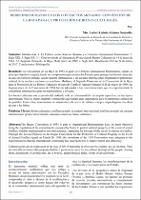DERECHOS HUMANOS EN LOS CONFLICTOS ARMADOS: CONVENCIÓN DE LA HAYA PARA LA PROTECCIÓN DE BIENES CULTURALES.
Abstract
The Hague Convention of 1954 is part of International Humanitarian Law, its main objective being the regulation of the commitments assumed by States to protect cultural property in the event of armed conflict, whether international or non-international, respecting the heritage of the nation or nations in conflict. Through the Second Protocol to the Hague Convention for the Protection of Cultural Property in the Event of Armed Conflict signed on March 26, 1999, the provisions of the 1954 Convention were adequate to the transformations that the international community has undergone for its improvement and efficiency.
Cultural goods are an expression of the way of life of humanity or of a specific country, at a given time. They are movable or immovable property that have great importance for the cultural heritage of the people. Among them, monuments of architecture, art or history, archaeological fields, works of art and books.

